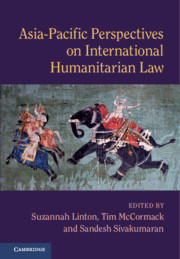Book contents
- Asia-Pacific Perspectives on International Humanitarian Law
- Asia-Pacific Perspectives on International Humanitarian Law
- Copyright page
- Contents
- Figures and Tables
- Contributors
- Foreword
- Foreword
- Acknowledgements
- Editors’ Note
- 1 Introduction: Asia-Pacific Perspectives on International Humanitarian Law
- Part I Interviews
- Part II Development of International Humanitarian Law
- 6 The Origins and Evolution of Humanitarian Action in Southeast Asia
- 7 Humanitarianism in Chinese Traditional Military Ethics and International Humanitarian Law Training in the People’s Liberation Army
- 8 Military Practices in Ancient India
- 9 Asia-Pacific States and the Development of International Humanitarian Law
- 10 International Humanitarian Law and the Asia-Pacific Struggles for National Liberation
- 11 The Vietnam War and the Development of International Humanitarian Law
- 12 Critical Issues in the Regulation of Armed Conflict in Outer Space
- Part III Practice and Application of International Humanitarian Law
- Part IV Implementation and Enforcement of International Humanitarian Law
- Part V Looking to the Future and Enhancing Compliance with International Humanitarian Law
- Glossary of Publications
- Alphabetical Glossary of Cases and Decisions
- Chronological Glossary of Cases and Decisions
- Treaties and Other International Instruments, Resolutions and National Documents with an International Dimension
- Chronological Glossary of National Legislation and Secondary Instruments
- Peace Agreements and Communiques
- Abbreviations and Translations
- Index
10 - International Humanitarian Law and the Asia-Pacific Struggles for National Liberation
from Part II - Development of International Humanitarian Law
Published online by Cambridge University Press: 18 October 2019
- Asia-Pacific Perspectives on International Humanitarian Law
- Asia-Pacific Perspectives on International Humanitarian Law
- Copyright page
- Contents
- Figures and Tables
- Contributors
- Foreword
- Foreword
- Acknowledgements
- Editors’ Note
- 1 Introduction: Asia-Pacific Perspectives on International Humanitarian Law
- Part I Interviews
- Part II Development of International Humanitarian Law
- 6 The Origins and Evolution of Humanitarian Action in Southeast Asia
- 7 Humanitarianism in Chinese Traditional Military Ethics and International Humanitarian Law Training in the People’s Liberation Army
- 8 Military Practices in Ancient India
- 9 Asia-Pacific States and the Development of International Humanitarian Law
- 10 International Humanitarian Law and the Asia-Pacific Struggles for National Liberation
- 11 The Vietnam War and the Development of International Humanitarian Law
- 12 Critical Issues in the Regulation of Armed Conflict in Outer Space
- Part III Practice and Application of International Humanitarian Law
- Part IV Implementation and Enforcement of International Humanitarian Law
- Part V Looking to the Future and Enhancing Compliance with International Humanitarian Law
- Glossary of Publications
- Alphabetical Glossary of Cases and Decisions
- Chronological Glossary of Cases and Decisions
- Treaties and Other International Instruments, Resolutions and National Documents with an International Dimension
- Chronological Glossary of National Legislation and Secondary Instruments
- Peace Agreements and Communiques
- Abbreviations and Translations
- Index
Summary
This chapter will analyse the contribution of States in the Asia-Pacific region to the ‘freedom fighter’ resolutions of the 1960s and 1970s that paved the way for the conclusion of the Protocol Additional to the Geneva Conventions of 12 August 1949, and Relating to the Protection of Victims of International Armed Conflicts of 8 June 1977 (AP I). It will question the relevance of Article 1(4) of AP I in the post-colonial landscape in which the independence wars against colonialism were largely over by 1977, leaving only delayed decolonization and foreign military occupation, as in East Timor, or non-international armed conflicts (NIACs) like those in Aceh and Mindanao, and ‘below-the-radar’ situations such as the one in West Papua. The meaning and importance of a ‘national liberation struggle’ in the post-colonial Asia-Pacific region will have to be considered in the context of the modern-day geopolitics in which these States distinguish between terrorists, insurgents, rebels and traitors taking up arms against them, on the one hand, and genuine freedom fighters, on the other hand.
- Type
- Chapter
- Information
- Asia-Pacific Perspectives on International Humanitarian Law , pp. 139 - 155Publisher: Cambridge University PressPrint publication year: 2019

